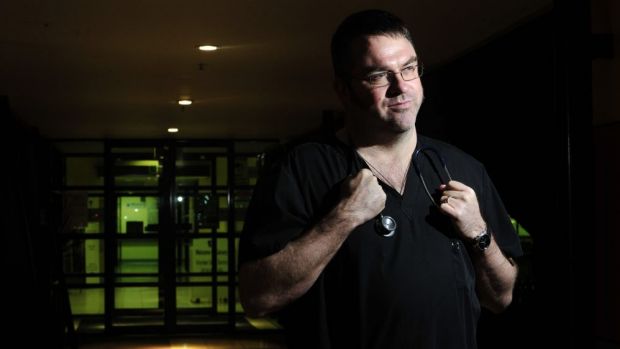
Dr David Caldicott says drunken visits to Canberra’s emergency departments has created a “phenomenal burden” for medical professionals. Photo: Melissa Adams
A spike in drunken visits to Canberra’s two emergency departments has created a “phenomenal burden” for medical professionals and is costing ACT taxpayers billions of dollars each year.
According to ACT Health figures, the number of patients presenting with alcohol related issues increased by 35 per cent between 2009 and 2013 and one of Canberra’s most experienced physicians believes the problem is getting worse.
“The impact of alcohol on the health of Australians is hugely underestimated and runs into the billions of dollars each year,” Dr David Caldicott, a Calvary Hospital emergency department physician said.
Dr Caldicott said at 2am on December 2, when a national survey was conducted, around 20 per cent of patients in Canberra’s two emergency departments were intoxicated and seeking treatment for either acute or chronic problems associated with drinking.
“There’s nothing else that does that,” he said.
“If 20 per cent of patients were there as consequence of a new infectious disease or a new recreational drug then you can imagine what the outpouring of resources might be, but this is a traditional recreational drug that is legal.”
According to the ACT Alcohol Tobacco and Other Drug Association, visits to Canberra’s emergency departments for injuries attributable to alcohol increased by 23.7 per cent during 2009-13.
Dr Caldicott said the increasing trend made an already demanding job more difficult for nurses and doctors.
“An emergency department at 2am on Sunday morning can be quite miserable and it’s not the norm for these patients to be polite and courteous with staff,” he said.
Dr Caldicott said nursing staff in emergency departments are occasionally verbally abused or harassed by intoxicated patients known to soil themselves or vomit.
“We deal with that and that’s part of the job,” he said.
“Experienced nursing staff are rather extraordinary in the way they deal with intoxicated patients on the front line and don’t exhibit the hubris the medical profession sometimes does.
“Emergency department nurses are one of the most pragmatic species to work the face of the earth.”
Dr Caldicott said there was not a lot emergency department staff could do to address the problem other than documenting the issue for policy makers.
Leeanne Trenning, director of the College for Emergency Nursing Australasia, said emergency department nurses often bear the brunt of alcohol-related aggression.
“Nurses are being subjected to violence and abuse from the very people they’re trying to help, she said.
“Intoxicated patients take up too much of our time and their behaviour negatively impacts the entire emergency department.”
The Australasian College for Emergency Medicine is one organisation calling for the government to adopt a tougher stance on intoxicated patients in emergency departments.
In November, the college found 92 per cent of emergency department doctors and nurses had experienced assaults or physical threats from drunken patients in the last 12 months.
The study reported on a heavily pregnant woman being punched in the stomach, a physician being knocked unconscious by a drunken patient, and a heart attack patient too intimidated to sit beside an intoxicated patient.
Lead researcher Dr Diana Egerton-Warburton said emergency department staff “are sick and tired of violence from drunk patients and how it affects their ability to treat other patients”.
“It’s time for policy makers and society to say, ‘enough is enough’,” she said.
“This violence is preventable with good public health policies.”
Dr Caldicott said he would like to see alcohol advertising be “regulated much more rigorously”.
“In terms of policy in Australia, we are the last great cowboy territory where basically there is very little supervision of what the alcohol industry can and can’t do,” he said.
“We need to look at the measures we can implement to change the way people are drinking in this country.”
